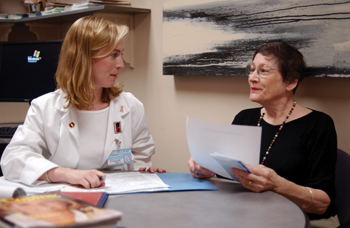
Elizabeth Broome, R.N., M.S.N., a research clinical specialist in Vanderbilt-Ingram Cancer Center's Clinical Trials, discusses the STAR trial with participant Pat Sanders.
Photo by Dana Johnson
Trial adds new weapon in war on breast cancer
Initial Results of the five-year Study of Tamoxifen and Raloxifene, or STAR, released this week revealed the osteoporosis drug raloxifene has been proven to be as effective as tamoxifen in preventing invasive breast cancer.
Vanderbilt-Ingram Cancer Center was the only regional participant in the study, one of the largest prevention trials ever conducted. Initial results show that the drug raloxifene, currently used to prevent and treat osteoporosis in postmenopausal women, works as well — with fewer side effects — as tamoxifen in reducing breast cancer risk for postmenopausal women at increased risk of the disease.
Investigators said both drugs reduced the risk of developing invasive breast cancer by about 50 percent. In addition, women who were prospectively and randomly assigned to take raloxifene daily, and who were followed for an average of about four years, had 36 percent fewer uterine cancers and 29 percent fewer blood clots than the women who were assigned to take tamoxifen. Researchers said uterine cancers, especially endometrial cancers, are a rare but serious side effect of tamoxifen. Both tamoxifen and raloxifene are known to increase a woman's risk of blood clots.
“The results are similar to what I expected,” said Mark Kelley, M.D., chief of Surgical Oncology at Vanderbilt-Ingram. “Raloxifene was equivalent to tamoxifen in terms of reducing the risk of invasive breast cancer, and had a more favorable side effect profile in several areas, including endometrial cancer risk, deep vein thrombosis and pulmonary embolus, and cataract risk. It appears that both drugs were equivalent in terms of bone fractures, stroke, heart attack risk and quality of life.
“I believe that this makes raloxifene the drug of choice for risk reduction in postmenopausal women at increased risk of developing breast cancer.”
Both raloxifene and tamoxifen are known to protect bone health and it's estimated that 500,000 postmenopausal women are currently taking raloxifene to prevent or treat osteoporosis. Additionally, the initial results from the STAR trial suggest that raloxifene does not increase the risk of developing a cataract, while tamoxifen does.
“Although no drugs are without side effects, tamoxifen and raloxifene are vital options for women who are at increased risk of breast cancer and want to take action,” said Leslie Ford, M.D., associate director for clinical research in NCI's Division of Cancer Prevention. “For many women, raloxifene's benefits will outweigh its risks in a way that tamoxifen's benefits do not.”
The researchers also tracked known menopausal side effects that occur with both drugs and monitored the participants' quality of life. They found that side effects of both drugs were mildly to moderately severe, and quality of life was the same for both drugs.
More than 19,000 postmenopausal women at high risk for developing breast cancer were enrolled in the trial. Vanderbilt-Ingram was one of 400 sites in the United States, Puerto Rico and Canada that participated in the study. Only five sites in Tennessee enrolled patients in the study, and Vanderbilt was the only hospital in the Middle Tennessee region. A total of 52 women were enrolled at Vanderbilt, including a handful at a sub-site at East Tennessee State University in Johnson City. Overall, 271 women were enrolled in Tennessee. Participants were randomly assigned to receive either 60 mg of raloxifene or 20 mg of tamoxifen daily for five years.
Paula Johnston enrolled in the study at Vanderbilt-Ingram. The 57-year-old lost her only sister to breast cancer last year and her mother had two mastectomies 15 years apart for breast cancer.
“Every year the odds get a little bit worse. Everybody I know has someone who has had to deal with it. You don't have to look too far to find someone,” said Johnston.
She has three daughters, all in their 20s, and her sister left two girls behind when she died. Johnston said she felt participating in the STAR trial was important. “I wanted to be a part of it because of all the girls in the family. We don't know what's just around the corner.”
Patricia Sanders, 68, of Murfreesboro also participated in the study. Her sister had a lumpectomy for breast cancer and her mother and aunt died from the disease.
“I want to do what I can to prevent it,” said Sanders.
The trial was coordinated by the National Surgical Adjuvant Breast and Bowel Project (NSABP), a network of cancer research professionals, and was sponsored by the NCI.
Participants in the STAR trial are now receiving information about which drug they were taking. Women assigned to raloxifene will continue to be provided with the drug until they have completed five years of treatment, while women assigned to tamoxifen can choose to continue taking tamoxifen or to receive raloxifene to complete their five years of treatment.













